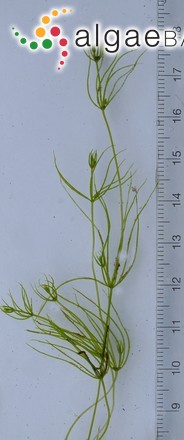Chara globularis Thuiller 1799

Current name: Chara globularis Thuiller - 08 September 2010. Anders Langangen (langangen@hotmail.com)
Publication Details
Chara globularis Thuiller 1799: 472
Published in: Thuillier, J.L. (Ann VII [1799]). Flore des environs de Paris, ou, Distribution méthodique des plantes qui y croissent naturellement, Faite d'après le systême de Linnée: avec le nom et la description de chacune et latin et in françoise; l'indications de leur lieu natal, de leur durée, du temps de leur florasion, de la coluleur de leurs fleurs, et al citation de Auteurs qui les ont le mieux décrites ou en ont donées les meilleures figures. Nouvelle édition: revuew corrigée et considérablement augumentée [éd. 2]. pp. 1-595. Paris: Chez l'Auteur et H.L. Perronneau.
Type Species
The type species (lectotype) of the genus Chara is Chara vulgaris Linnaeus.
Status of Name
This name is of an entity that is currently accepted taxonomically.
Type Information
Type locality: "Habitat in aquis pigris" [environs of Paris, France]; (Thuillier 1799: 472) Lectotype: PC 0074031 (epitype) Thuillier (no location spcified); no date; L; 0054649 (Sakayama et al. 2009: 926) Notes: Epitype designated by Sakayama et al. (2009: 926): PC 9974031 (no date, Desvaux?).
General Environment
This is a freshwatermarine species.
Description
Plants are from 5 to 50 cm long, commonly green in colour, but encrusted and grey in calcareous waters. The axis is up to 500 µm in diameter and in some cases up to 800 µm in diameter. The internodes are as long as, or longer than the branchlets. The branchlets are 6-9, each with 8-12 segments. The stem cortex is triplostichous, isostichous. The spine cells are lacking or papillous. The stipulodes in both rows are very short or papillous. The plant is monoecious. The gametangia are conjoined at the three lowest branchlet nodes. The oogonia are solitary and up to 1.2 mm long. The oospores are black. The antheridium is up to 500 µm in diameter.
Habitat
Chara globularis is found both in freshwater and brackish water. In freshwater it is found in lakes and rivers, oligotrophic as well as eutrophic water. In calcareous lakes the species can be heavily encrusted. It grows on a sand, clay, mud or marl bottom. It is usually found in shallow water, down to 4 m depth. In brackish water it is common in the Swedish part of the Baltic Sea. It is commonly annual but perennial forms are found on deeper water. The species is fertile from May to September, in the Baltic Sea from July. It is often richly fertile and often full of ripe, black oospores which are found from June to October.
Created: 11 April 2002 by M.D. Guiry.
Last updated: 03 April 2023
Verification of Data
Users are responsible for verifying the accuracy of information before use, as noted on the website Content page.
Linking to this page: https://www.algaebase.org/search/species/detail/?species_id=27163
Citing AlgaeBase
Cite this record as:
M.D. Guiry in Guiry, M.D. & Guiry, G.M. 03 April 2023. AlgaeBase. World-wide electronic publication, National University of Ireland, Galway. https://www.algaebase.org; searched on 21 November 2024
 Request PDF
Request PDF














